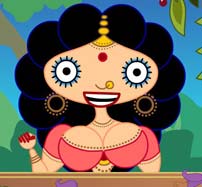 How does a journalist become a part of a story that he is covering? I first met filmmaker Nina Paley in 2005 when she and some of her friends were hosting an animation party on the roof top of her Brooklyn apartment building. Paley had a short film that was a feminist take on the Ramayana called “Sita Sings the Blues,” with colorful drawings of Sita–her big breasts, thin waist, and round hips, and featured sad jazz songs by a 1920s singer Annette Hanshaw.
How does a journalist become a part of a story that he is covering? I first met filmmaker Nina Paley in 2005 when she and some of her friends were hosting an animation party on the roof top of her Brooklyn apartment building. Paley had a short film that was a feminist take on the Ramayana called “Sita Sings the Blues,” with colorful drawings of Sita–her big breasts, thin waist, and round hips, and featured sad jazz songs by a 1920s singer Annette Hanshaw.
As a film writer, I was very impressed by Paley’s work–a fresh exploration of Ramayana, with Sita expressing her emotions through Hanshaw’s song: her unconditional love for Rama and her inability to understand why he sometimes doubted her and put her through difficult tests. And as a Hindu, I appreciated that Paley was respectful of the characters from the Ramayana. But I never thought that one day I’d be part of Paley’s “Sita” work.
“Sita” is now a full length animated feature. I accompanied Paley and some other members of her team to the 58th Berlinale, a film festival where it won a special jury mention. And “Sita” has had its North American premiere at the Tribeca Film Festival last Friday.
But where does my part in this take place? For the past couple of years, Paley has shown small segments of “Sita” at various film festivals in the U.S. And until last year I had observed the line between the journalist and the film–only talking about the project in public spaces.
Then last summer Paley invited three people, including myself, to a recording studio in Manhattan. What followed was one hour of unscripted recording: Paley throwing questions at us about the Ramayana and three of us interpreting the text. In the process we humanized Rama, Sita, and the other characters from the Ramayana, sometimes praising them and at other times questioning their motives and finding flaws in them. We were a funny, lively group. Now this conversation has become the central narrative of the film.
The story of Sita is appealing on so many levels. Check it out if you can.
–written by Aseem Chhabra


